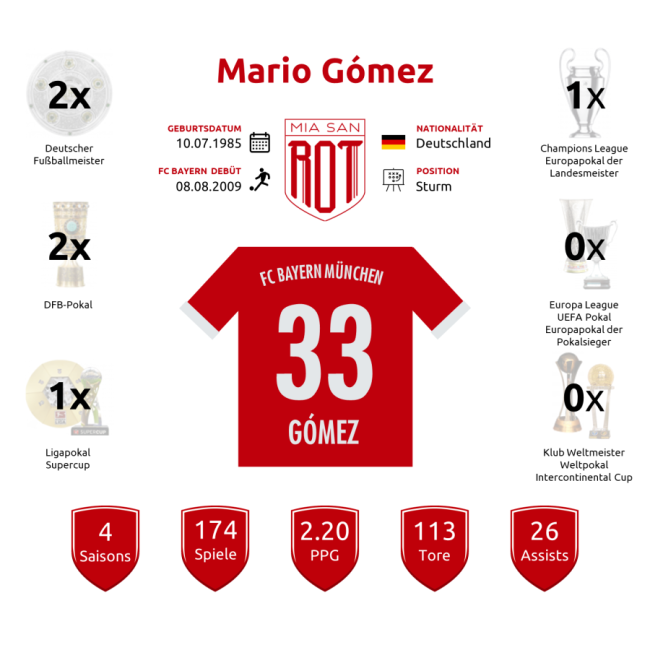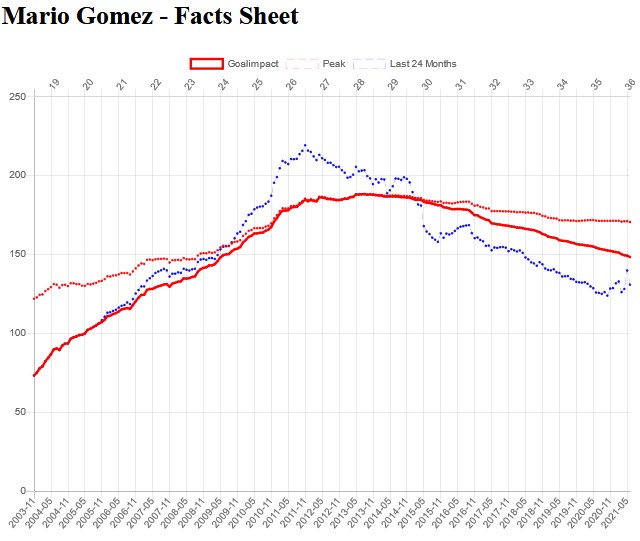FC Bayern – Miasanrot Advent Calendar, Door 33: Mario Gomez
THE ODDS-ON STRIKER
Mario Gómez is the last world-class striker to date coming out of the footballing country of Germany. Although he is regrettably not as highly regarded as his great predecessors in this country, he certainly doesn’t have to hide behind the Hrubeschs, Fischers, Klinsmanns or Bierhoffs. For center-forwards, the numbers are often enough to reveal who’s got class, and Gómez’s numbers speak for themselves: 87 goals in 156 games as a still fairly young player during his first time in Stuttgart. 113 goals in 174 games during his time with FC Bayern. 31 goals in 78 games for the German national team.
At first glance, one recognises top class, but only the second look reveals the incredibility of his achievement. Don’t forget that Gómez’s first year at Bayern was famously disastrous. He got next to no playing time scoring just a handful of goals, which severely weighs down Gómez’s overall numbers. Take those out and his already uncanny rate gets even better: 99 goals in 129 games, or 0.77 goals per game. That’s a dimension that you don’t really find with players other than Lionel Messi and Cristiano Ronaldo. And if you go one step further and narrow the perspective one last time, the numbers improve even more: In his last season at Bayern, he famously lost his regular place for long periods, yet he still managed 19 goals in 32 games. Once again, an unbelievable quota in itself. But in fact it was not 32 games at all, as often as he was only allowed to come on for the last few seconds. So if we consider only his absolute prime in the 2010/11 and 11/12 seasons, we are at a final 80 goals in 97 games, or 0.82 goals per game.

That is an incredible rate. Philosophical discussions about his pressing behaviour or contribution to overall play aside: This scoring rate in itself is testimony to world class.
A COUNTER-ATTACK PLAYER IN A BALL-POSSESSION WORLD
When Mario Gómez ended his career two years ago having facilitated the resurgence of VfB Stuttgart, I already wrote a farewell to him. Details about his unexpected comeback under van Gaal and which so-called “world-class strikers” he effortlessly left in the dust in the Champions League have been immortalized there and will not be resuscitated here.
Instead, the focus here is on the type of player Mario Gómez is. Through his years at FC Bayern, the German national team, and due to his numerous injuries, many may have forgotten that Gómez was actually once a classic counter-attacking striker. He may have had the frame of a proper striker, but not the style of play. Charging down at an disorganized defence at great speed was Mario Gómez’s forte in his attention-getting early Stuttgart days.
It is only logical that FC Bayern saw this and wanted to see it replicated for them. In fact, one can very well imagine how a Mario Gómez at FC Bayern in the 00s could often have found himself in very similar attacking situations as he did at Stuttgart. Although no less favourites than in the following decade, Bayern’s games were still very different back then. Balanced possession was the order of the day, no opponent solely sat deep, digging in in their own penalty area. One dribble won by Zé Roberto and there was plenty of space in front of the attackers. Roy Makaay might have been a good striker. Luca Toni in his heyday might even have been a very good one. Mario Gómez, however? With the freedom he had at the time, he would have laid waste to the league.
But I am indulging in blissful subjunctive. In fact, Gómez’s move to Bayern coincided with a growing divide in world football. Some hoarded the ball, others countered. That the latter also needed solutions with the ball only became clear later, when teams simply dug in at the back too and refused to be counter-attacked.
It is a biting irony of fate that in the heyday of the counter-attacking beast Borussia Dortmund, the born possession striker Robert Lewandowski stormed forward, while at the very front of the ball hogging machine Bayern Munich, a lonely Mario Gómez scored one goal after another, and yet critics did not completely come round. Certainly, Lewandowski only invented himself as a wall player later on at Bayern, but even then his technique and playing skills were so conspicuous that he initially featured in midfield before Jürgen Klopp put him in the position where he was to make his mark on world football.
Why was Gómez criticised despite his exhilarating goal tally? Why did Joachim Löw prefer a 34-year-old Miroslav Klose from Lazio Rome? Well, on the one hand, of course, there is a populist, harsh and ultimately completely unfair criticism that did not fail to leave its mark. Uli Hoeneß’ notorious tirade that Gómez was not a very good striker because otherwise they would have beaten Chelsea in the final dahoam should be counted in this category.
But there is also a legitimate strand of criticism of Gómez and this mostly is about questions of play style. Although Gómez developed the skills of a striker involved in his team’s play over time, his qualities in ball retention ultimately reached a limit. For two years, FC Bayern simply could not cope with Dortmund’s pressing under Jürgen Klopp, and one key to why things were different in the third year was Gómez’s successor Mario Mandžukić. He didn’t have Gómez’s nose in front of goal, but when Klopp’s bloodhounds chasing after every ball forced the Bayern defenders to frequently hit the ball long, Mandžukić was able to bring down and hold the ball against the towering opposing defenders and put it on to Bayern’s more skilful ball handlers advancing.
FATEFUL DESCENT?
And yet, in hindsight, one should not make the mistake of claiming an inevitable development. It is by no means certain that replacing the two Marios was a necessity for FC Bayern to be able to finally bag the treble. Javi Martínez, an improved pressing and further facilitating factors such as a more positive mood at the club might have done the job already.
One must never forget: It was injuries that put the brakes on Mario Gómez’s incredible run. Couch pundits could have extolled to no end what singular contribution Mario Mandžukić brought to the Bayern game. But would Gómez really have lost his place if he had continued to score in every other game? Isn’t world football full of successful teams whose centre-forwards did little more than hit the ball in the back of the net?

(Source: Goalimpact)
Real Madrid with Cristiano Ronaldo is a prime example of a successful team with a top striker up front who really gives the team nothing else except goals, goals and goals. Those who now start decrying the comparison with perhaps the best striker in football history are reminded once again of Gómez’s goal rate: 0.82 was his best. So the comparison is legitimate. And away from goals, Gómez gave more to his teams than the ever-so-stubborn Ronaldo ever did.
Epically bad career planning
No, it was not set in stone that Mandžukić outperformed Gómez at FC Bayern, nor was it set in stone that Gómez never again approached the world class of those days. At first, injuries only cost him his regular place at FC Bayern, but at his next club, AC Florenz, they cost him his entire reputation.
In just three years, a striker who scored 12 times in one season in the Champions League dropped to a level where his only remaining option was to go to Turkey. Injuries may have been responsible for the break in his career, but it was also due to very poor career planning that he eventually had to descend all the way to Turkey.
Mario Gómez is a dazzling example of why one must not sell oneself short, of why one must not descend too many steps on the career ladder at once. If you moved down a tier from a reigning Champions League winner, you would get to clubs like Juventus Turin at that time. If he had been dealt the same injury misfortune there as he was at Florence, he would surely have found a good club in a top European league. But Gómez moved from the Champions League winner to a club that had been 13th and 4th, respectively, in the past two years in Serie A.
Ironically, Mario Mandžukić’s example once again shows how to successfully leave FC Bayern. He did not join Italian middle class, but Atlético Madrid, who were seconds away from a Champions League triumph that season. And although things didn’t quite click between Atlético and Mandžukić and he chose to move on, he didn’t end up on the sidelines (or in Turkey), but at no less a club than Juventus.
Finally recovered from his injuries, Mario Gómez was able to play a lot again and did what a much-playing Gómez always did: score with the reliability of a swiss watch, and it is precisely here that the tragic aspect of his poor club choices of past years comes to the fore: the renaissance of the now 30-year-old Mario Gómez was literally wasted during one year in Turkey and one at the completely dysfunctional VfL Wolfsburg. At Beşiktaş the competition was below his level, at Wolfsburg the entire club. Single-handedly, he kept them in the league. Needless to say, he again had goal-scoring rates beyond good and evil in both seasons.





